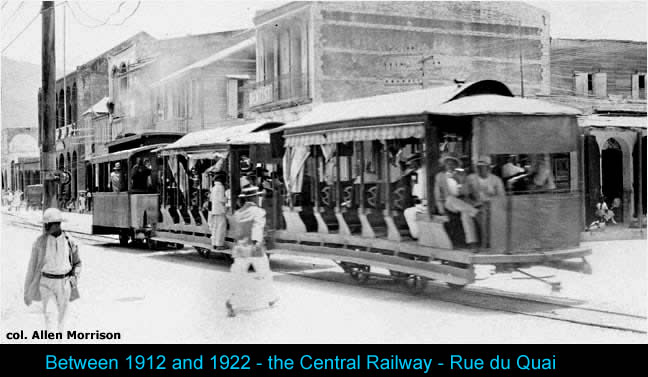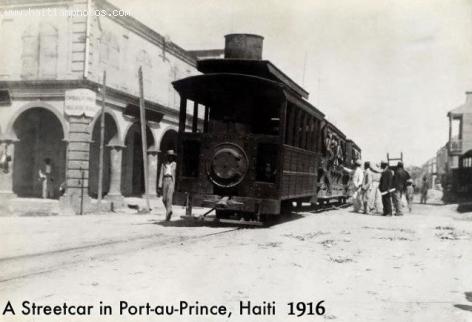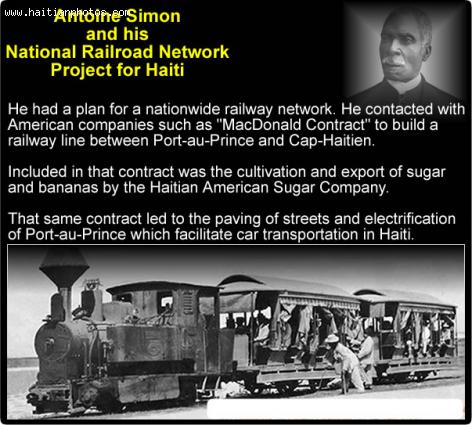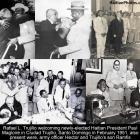ADVERTISEMENT
Train
Central Railway in Port-au-Prince, Cincinnatus Leconte government
Here is a picture of the Central Railway in Port-au-Prince at Rue du Quai during the government of Cincinnatus Leconte
Jean-Jacques Dessalines Michel Cincinnatus Leconte (born September 29, 1854) was the Haitian President between (August 1911 until his death on 8 August 1912). He was the son of Cinna Leconte and Florelia Raphael and the great grandson of the Jean-Jacques Dessalines, the founding father of Haiti and the autocratic first ruler of an independent Haiti under the 1801 constitution. Cincinnatus Leconte was a lawyer by profession who served as the Minister of the Interior to the President Pierre Nord Alexis. In 1908, when a revolt deposed Alexis, he went into exile in Jamaica and C. Antoine Simon became the President. He came back from exile in 1911 and gathered a rebellion force that ousted President Simon and on August 7, 1911, Leconte unanimously became the President for a seven year term with a set salary of $24,000 a year. His presidency is often considered as one of the efficient and cleanest government that Haiti ever had. He took many positive steps and numerous reforms. He increased teachers' pay, paved the streets, installed telephone lines, reduced the size of the army, etc., and they are only a few to name. He introduced a controversial discriminatory policy targeting "Syrian" population (actually most of them were Lebanese Christians) to protect Haitians from disloyal competition of the Easterners with uncertain nationality.
Street Car during Antoine Simon Presidency
Anthony Simon as a President of the country in 1909 realized the role of modernity, technology and industrialization in a country's development. He understood how a good railway network can hasten the economic growth in Haiti. During his time, velocipede (early bicycles having pedals attached to the front wheel) became popular, people attended movie shows, gramophone, telephone, sewing machine, and camera became common objects in wealthy families..... In short, the country silently entered the age of modernity.
It was his opinion that export revenue from "fig banana" would be enough to finance his dream railway project between Port-au-Prince and Cap-Haitien. The government of Anthony Simon raised a loan of 65 million francs in France on abusive terms to finance his railway project. His critics complained of serious diplomatic and financial difficulties and warned of the threat that the Americans may invade Haiti in pretext of earlier McDonald's contract (that contained massive dispossession of land). In reality, most of President Simon's plans were some forms of utopia that never materialized in his lifetime in the beginning of the last century. His plans created more evils than good. To satisfy American planters, Haitian banana growers were taxed, electrification and paving of the streets increased the import bill through increased number of imported cars.
President Antoine Simon played dangerous gamble with Haitian economy and placed it in either win or ruin in debt for generations situation. The loan costs heavy obligations to the poor Haitians who paid with their pocket until the last penny. In 1972 Luckner Cambronne, a high-ranking political figure in François Duvalier's regime said the country did not need any railway and he systematically dismantled the railway track between Port-au-Prince and St. Marc. Here is how the incredible adventure of railway that cost so much tears and blood of the unfortunate Haitians ends.
Antoine Simon and his National Railroad Project
One of the major goals of President Antoine Simon was to build a railroad linking Port-au-Prince and Cap-Haitian.
To make this possible, Antoine Simon contracted with American companies such as "MacDonald Contract" to build a railway line between Port-au-Prince and Cap-Haitien. Included in that contract was the cultivation and export of sugar and bananas by the Haitian American Sugar Company. That same contract led to the paving of streets and electrification of Port-au-Prince which facilitate car transportation in Haiti.




 Henri Namphy Haitian General and President , buried in...
Henri Namphy Haitian General and President , buried in...  Le Chic Poulet by Haiti Broilers S.A.
Le Chic Poulet by Haiti Broilers S.A.  Nouveau College Bird in Port-au-Prince, Haiti
Nouveau College Bird in Port-au-Prince, Haiti  Delimart Plaza, Delmas 32, Port-au-Prince, Haiti being looted
Delimart Plaza, Delmas 32, Port-au-Prince, Haiti being looted  Pope Francis appointed Mgr. Launay Saturne Archbishop of...
Pope Francis appointed Mgr. Launay Saturne Archbishop of...  Jack Guy Lafontant resigns as Haiti Prime Minister
Jack Guy Lafontant resigns as Haiti Prime Minister  Rafael L. Trujillo welcoming Paul Magloire in Santo Domingo
Rafael L. Trujillo welcoming Paul Magloire in Santo Domingo  Haiti Street Food, manje kwit or Chin Janbe, for $1 or less
Haiti Street Food, manje kwit or Chin Janbe, for $1 or less 



